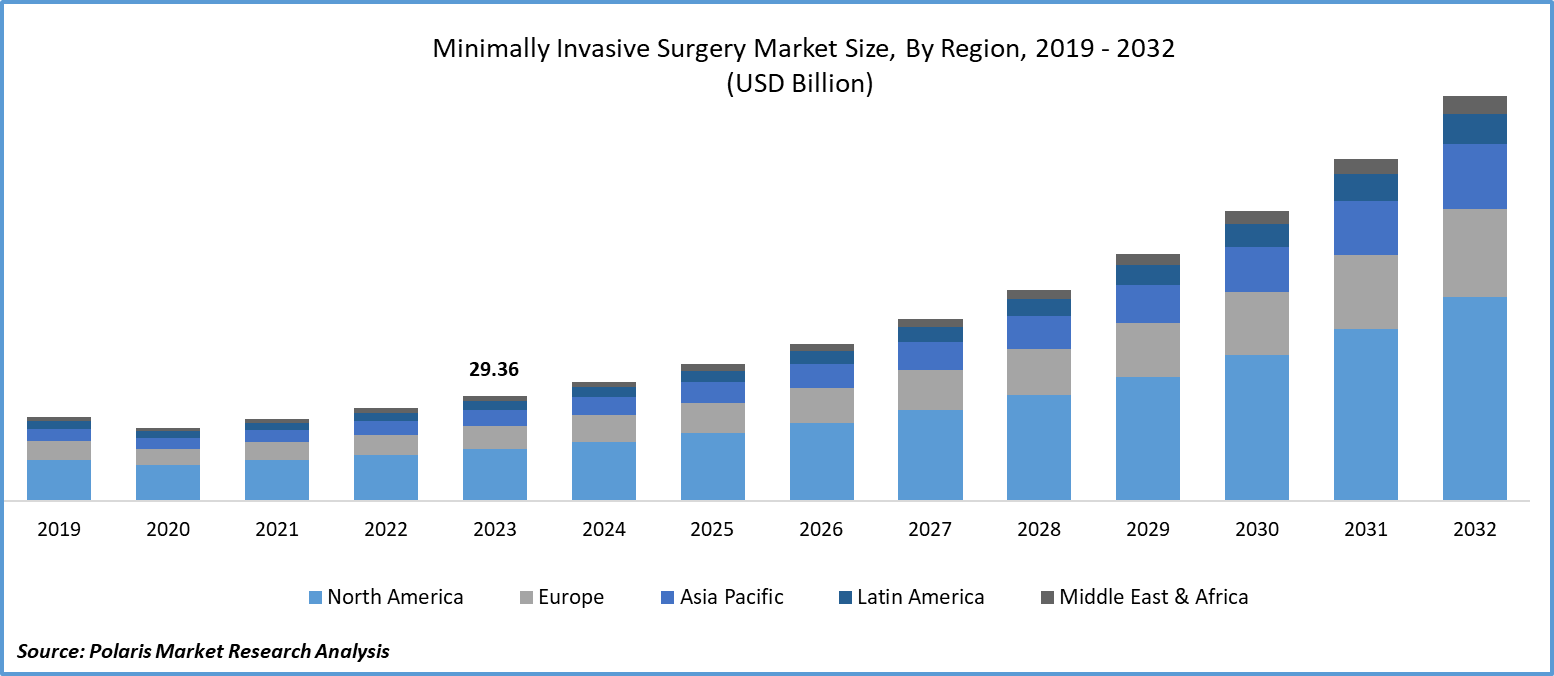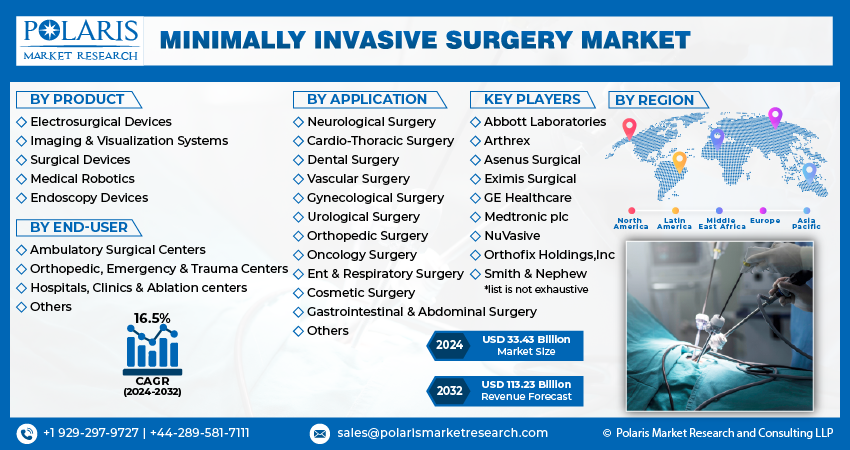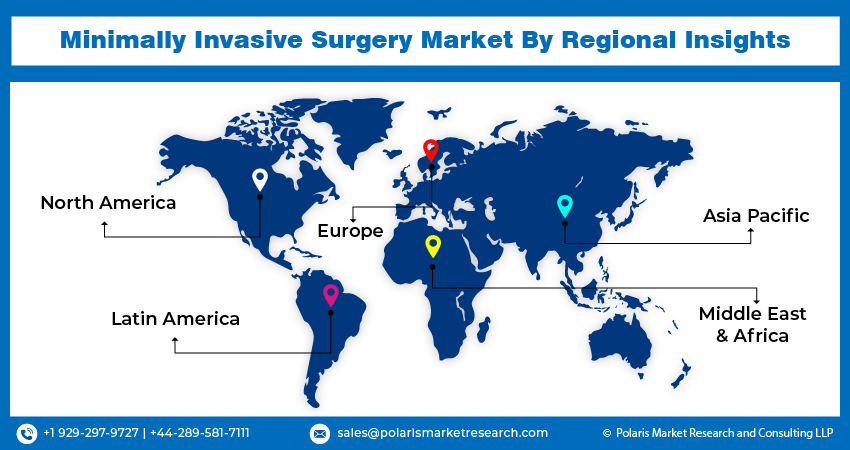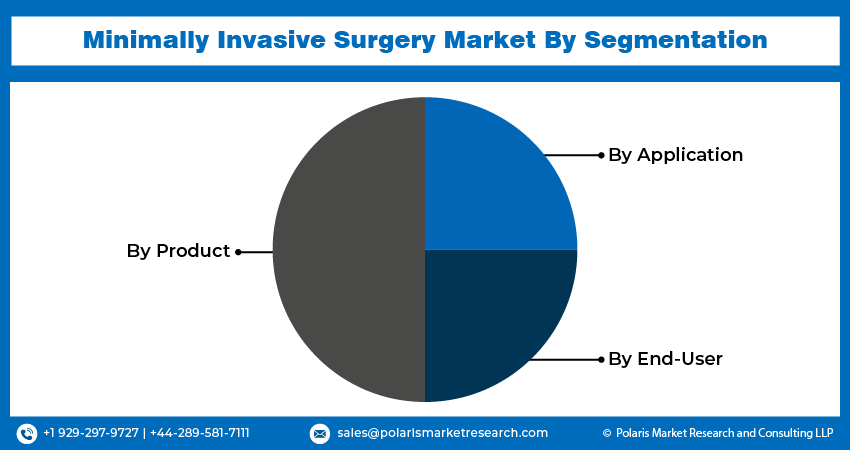
Minimally Invasive Surgery Market Share, Size, Trends, Industry Analysis Report, By Product (Electrosurgical devices, Imaging & Visualization Systems, Surgical Devices); By Application; By End-User; By Region; Segment Forecast, 2024 - 2032
- Published Date:Apr-2024
- Pages: 114
- Format: PDF
- Report ID: PM4808
- Base Year: 2023
- Historical Data: 2019-2022
Report Outlook
Global minimally invasive surgery market size was valued at USD 29.36 billion in 2023. The market is anticipated to grow from USD 33.43 billion in 2024 to USD 113.23 billion by 2032, exhibiting the CAGR of 16.5% during the forecast period
Minimally Invasive Surgery Market Overview
Minimally invasive surgery procedures utilize small instruments, cameras, and lights to minimize the size and number of incisions made during surgery. This approach is safer than traditional open surgery, resulting in fewer complications, faster recovery, reduced blood loss, better outcomes, and shorter hospital stays. These advantages have contributed to the growing popularity of minimally invasive surgeries among surgeons and patients worldwide. These procedures are primarily used in orthopedic, vascular, neurological, and cardiothoracic surgeries.
For instance, in January 2024, Arthrex recently introduced TheNanoExperience.com, a new patient-oriented resource that showcases the science and advantages of Nano arthroscopy. This innovative orthopedic procedure is minimally invasive and has the potential to facilitate a swift return to activity with reduced pain.

To Understand More About this Research:Request a Free Sample Report
The global minimally invasive surgery market opportunity is experiencing growth due to several key factors. These include an increased demand for minimally invasive procedures, higher funding from private and public organizations for healthcare infrastructure development, and ongoing technological advancements in the field. The prevalence of chronic diseases such as kidney, heart, respiratory, and gastrointestinal disorders is also contributing to this growth. For instance, in 2021, the World Health Organization (WHO) estimated that chronic diseases, including diabetes, cancer, respiratory disorders, and cardiovascular diseases, accounted for 4.1 million, 1.5 million, 9.3 million, and 17.9 million deaths worldwide, respectively. Chronic illnesses collectively claim 41 million lives annually, representing 71% of all global fatalities.
The increasing elderly population further propels the minimally invasive surgery market expansion, as older individuals are more susceptible to chronic ailments. Moreover, a surge in surgical procedures contributes to market growth. This growth is supported by advancements in robotic assistance technology and greater public recognition of the advantages of minimally invasive surgery. However, the high cost of these procedures is expected to restrict the market's expansion during the forecast period.
Minimally Invasive Surgery Market Dynamics
Market Drivers
Growing Number of Orthopedic Conditions
During the forecast period, the global minimally invasive surgery market development is expected to experience growth driven by an increasing prevalence of orthopedic disorders. For instance, at July 2022 according to the World Health Organization (WHO), as of approximately 1.71 billion people worldwide are affected by musculoskeletal disorders. The global population is aging, leading to a higher prevalence of orthopedic disorders such as osteoarthritis and fractures, particularly among older adults. This demographic trend is driving an increased demand for orthopedic surgeries. Simultaneously, advances in minimally invasive surgical techniques have enhanced the effectiveness and safety of these procedures for orthopedic conditions. Patients are increasingly choosing minimally invasive surgery due to its shorter recovery times, reduced post-operative pain, and lower risk of complications compared to traditional open surgeries.
Adoption of Mis More Often Than Open Procedures
Laparoscopic treatments are less invasive and cost-effective in comparison to traditional procedures, impacting hospital stays and pre- and post-operative care. Patients undergoing laparoscopic surgeries experience quicker recovery, reduced blood loss, and fewer post-operative complications. Additionally, in some countries, health insurance providers are starting to cover these minimally invasive procedures. This is because doctors believe that these procedures can help hospitals save money, making them preferential to traditional open surgeries.

Market Restraints
The Expensive Nature of Robotic Systems
Robot-assisted surgeries are notably more costly than less invasive procedures, often resulting in delays or the avoidance of treatment altogether. Adding to the already high expense of robotic surgery is the maintenance cost of around USD 125,000 per year. Decreases in hospital budgets have been noted across European countries, with further cuts anticipated in the future. As a result of these budget constraints, cost-containment strategies are becoming increasingly necessary in various areas of hospital operations.
Hazard of Unfavorable Events and Problems
Despite the advantages of less invasive surgical treatments, there is still a potential for complications, albeit less than with open surgeries. These complications can lead to shorter recovery periods and fewer issues overall. However, concerns about patient safety, including risks of organ damage, hemorrhage, or infection, during these treatments can make healthcare practitioners hesitant to use MIS techniques.
Report Segmentation
The market is primarily segmented based on product, application, end-user, and region.
|
By Product |
By Application |
By End-User |
By Region |
|
|
|
|
To Understand the Scope of this Report:Speak to Analyst
Minimally Invasive Surgery Market Segmental Analysis
By Product Analysis
The surgical devices segment led the industry market with substantial revenue share in 2023. Surgical devices are categorized into handheld instruments, laparoscopy devices, guiding devices, and inflation systems, all playing vital roles in minimally invasive surgery (MIS) and significantly enhancing surgical outcomes through their continuous development and innovation. Technological advancements are a key driver behind the expansion of MIS through surgical devices, aiming to improve the precision, flexibility, and safety of these instruments, ultimately benefiting patients. For instance, the evolution of advanced laparoscopic instruments has enabled surgeons to conduct intricate procedures more accurately and with less invasiveness. Furthermore, the minimally invasive surgery market growth is buoyed by the introduction of sophisticated surgical technologies by major industry players. These technologies often integrate robotics, artificial intelligence, and advanced imaging, empowering surgeons to perform procedures more efficiently and effectively.
By Application Analysis
The neurological surgery segment is expected to grow at the fastest growth rate over the minimally invasive surgery market forecast period. Several factors are driving the increased use of minimally invasive surgery (MIS) for neurological treatments. Technological advancements have improved the precision of minimally invasive interventions, particularly in imaging modalities and surgical instrumentation. There is also a strong incentive to reduce post-operative complications, decrease patient morbidity, and expedite recovery times, all of which are benefits of MIS in neurological surgery. Additionally, changing healthcare paradigms, which prioritize patient-centered outcomes and value-based care, are contributing to the incorporation of MIS in neurological surgery.
By End-User Analysis
Based on end-user analysis, the market has been segmented on the basis of Ambulatory Surgical Centers, Orthopedic, Emergency & Trauma Centers, Hospitals, Clinics & Ablation centers and Others. The hospital, clinics & ablation centers segment held the largest market share in 2023. During the minimally invasive surgery market forecast period, the hospitals segment is expected to be propelled by several factors. The following factors contribute to the rise in popularity of hospitals for surgical procedures in developing countries: the expansion of operating rooms, favorable reimbursement policies that attract patients, increased availability of high-tech minimally invasive surgery equipment, and the capability of hospitals to perform a variety of minimally invasive surgeries. For instance in 2022, According to the American Hospital Association, there were about 6,129 hospitals in the United States.
Minimally Invasive Surgery Market Regional Insights
The North America Region Dominated the Global Market with the Largest Market Share in 2023
The North America region dominated the global market with the largest market share in 2023 and is expected to maintain its dominance over the anticipated period. The exponential growth of minimally invasive surgery procedures is primarily driven by the increasing prevalence of chronic illnesses in the North American region. There is a paradigm shift occurring in skull-based surgery and neurosurgery, where lesions that were previously treated with open procedures are now being identified and removed using endoscopic techniques. The demand for these devices in the field is increasing due to the less invasive nature, faster recovery times, and lower treatment costs associated with minimally invasive procedures. Additionally, advancements in surgical instruments by leading US companies are expected to further fuel market growth. Factors such as the development of healthcare infrastructure, adoption of new technologies, and increased public awareness of alternative treatment options are also driving the minimally invasive surgery market expansion.
The Asia Pacific region is expected to be the fastest growing region, with a healthy CAGR during the projected period. The minimally invasive surgery (MIS) market development is primarily driven by factors such as an aging population, increasing healthcare costs, and investments in healthcare infrastructure. Patients are increasingly opting for MIS due to its perceived benefits, including shorter hospital stays, less pain, and faster recovery times compared to traditional surgery. As patient awareness and demand for MIS options grow, healthcare providers are more inclined to offer and recommend these procedures. This trend is supported by advancements in MIS techniques and surgical procedures. Additionally, the Asia Pacific market is expected to benefit from the rising number of regional manufacturers providing goods for minimally invasive surgery.

Competitive Landscape
The minimally invasive surgery market is fragmented and is anticipated to witness competition due to several players' presence. Major service providers in the market are constantly upgrading their technologies to stay ahead of the competition and to ensure efficiency, integrity, and safety. These players focus on partnership, product upgrades, and collaboration to gain a competitive edge over their peers and capture a significant market share.
Some of the major players operating in the global market include:
- Abbott Laboratories
- Arthrex
- Asenus Surgical
- Becton, Dickinson & Company
- Boston Scientific Corporation
- Eximis Surgical
- GE Healthcare
- Johnson & Johnson Medtech
- Medtronic plc
- NuVasive
- Orthofix Holdings,Inc
- Smith & Nephew
- Stryker corporation
- Virtual Ports
- Zimmer Biomet holdings
Recent Developments
- In November 2023, Medtronic announced FDA approval of a minimally invasive device to treat hypertension.
- In September 2023, Stryker announced the launch of PROstep MIS Lapidus, a new internal fixation system designed for treating bunions through a minimally invasive surgical reduction of hallux valgus deformity and subsequent fusion of the first metatarsal cuneiform joint.
- In April 2023, Orthofix expanded solutions for minimally invasive spine procedures with the full commercial launch of two access retractor systems.
Report Coverage
The Minimally Invasive Surgery market report emphasizes on key regions across the globe to provide better understanding of the product to the users. Also, the report provides market insights into recent developments, trends and analyzes the technologies that are gaining traction around the globe. Furthermore, the report covers in-depth qualitative analysis pertaining to various paradigm shifts associated with the transformation of these solutions.
The report provides detailed analysis of the market while focusing on various key aspects such as competitive analysis, product, application, end-user, and their futuristic growth opportunities.
Minimally Invasive Surgery Market Report Scope
|
Report Attributes |
Details |
|
Market size value in 2024 |
USD 33.43 billion |
|
Revenue forecast in 2032 |
USD 113.23 billion |
|
CAGR |
16.5% from 2024 – 2032 |
|
Base year |
2023 |
|
Historical data |
2019 – 2022 |
|
Forecast period |
2024 – 2032 |
|
Quantitative units |
Revenue in USD billion and CAGR from 2024 to 2032 |
|
Segments covered |
By Product, By Application, By End-User, By Region |
|
Regional scope |
North America, Europe, Asia Pacific, Latin America, Middle East & Africa |
|
Customization |
Report customization as per your requirements with respect to countries, region, and segmentation. |
FAQ's
key companies in Minimally Invasive Surgery Market are Medtronic plc, Johnson & Johnson Medtech, Stryker Corporation, NuVasive, GE Healthcare, Zimmer Biomet Holdings, Becton
Minimally Invasive Surgery Market exhibiting the CAGR of 16.5% during the forecast period
The Minimally Invasive Surgery Market report covering key segments are product, application, end-user, and region.
key driving factors in Minimally Invasive Surgery Market are Growing Number of Orthopedic Conditions
The global Minimally Invasive Surgery market size is expected to reach USD 113.23 billion by 2032

